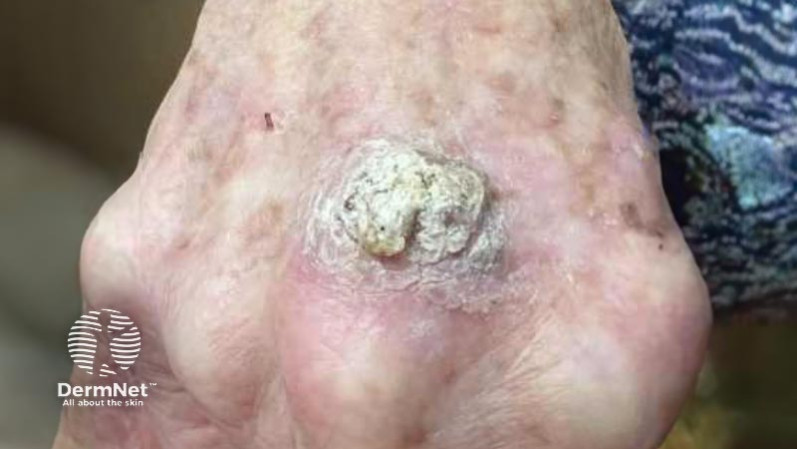Main menu
Common skin conditions

NEWS
Join DermNet PRO
Read more
Quick links
Scaly nodule on hand
Last reviewed: January 2024
Author: Dr Stanley Leong, Dermatology and Paediatric Registrar, New Zealand (2024)
Reviewing dermatologist: Dr Ian Coulson (2024).
Edited by the DermNet content department

Background
This 70-year-old presented with a scaly, tender, itchy nodule on the back of her right hand.
She had a renal transplant 18 years previously, and remained on multiple immunosuppressants (mycophenolate, azathioprine), and prednisone.
On examination, she had a solitary hard raised lesion on the dorsal hand with significant hyperkeratosis. There was no bleeding or ulceration.
What is the most likely diagnosis for the lesion?
This is a cutaneous squamous cell carcinoma (SCC).
SCC is a common skin cancer derived from keratinocytes. It is invasive and can sometimes metastasise and be fatal. The mortality rate is around 2–5%.
What are the clinical features of this type of lesion?
SCC usually begins as a tender erythematous papule or nodule. It usually has surface scales. It tends to grow faster than basal cell carcinomas (BCCs).
Some SCCs can bleed or ulcerate. They are usually located on sun-exposed sites such as the face, lips, ears, bald scalp, forearms, hands, and lower legs.
Most SCCs arise from actinic keratoses (AK) or SCC in situ.
How can this condition be prevented?
SCCs are five times more common in solid organ transplant recipients who are on systemic immunosuppressants. The longer the period of immunosuppression, the greater the risk of SCC development. Education regarding this risk of skin cancer, its early presenting features, and rapid access to specialists is essential.
Vigilant sun protection is essential for high-risk patients. Patients should be advised to minimise sun/ultraviolet (UV) light exposure and wear sun protective clothing such as a wide-brimmed hat, long-sleeved shirt, and long pants. They should also apply SPF 50+ sunscreen with UVA and UVB blocking properties regularly when outdoors.
Oral acitretin has been shown to reduce SCC development in solid organ transplant recipients by 20–30%.
